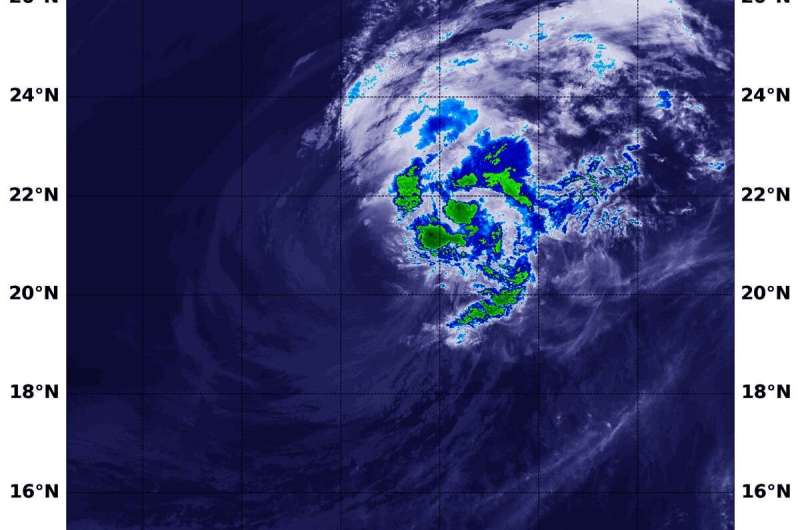On Oct.5 at 6:20 a.m. EDT (1020 UTC), the MODIS instrument that flies aboard NASA's Aqua satellite gathered infrared data on Marie that confirmed wind shear was adversely affecting the storm. Persistent westerly vertical wind shear showed strongest storms (yellow) pushed east of the center where cloud top temperatures were as cold as minus 50 degrees Fahrenheit (minus 45.5 Celsius). Credit: NASA/NRL
NASA's Aqua satellite provided an infrared view of Tropical Storm Marie that revealed the effects of outside winds battering the storm.
Wind shear occurs when winds at different levels of the atmosphere push against the rotating cylinder of winds, weakening the rotation by pushing it apart at different levels.
NASA's Aqua Satellite Reveals Effects of Wind Shear
Infrared light is a tool used to analyze the strength of storms in tropical cyclones by providing temperature information about a system's clouds. The strongest thunderstorms that reach highest into the atmosphere have the coldest cloud top temperatures. This temperature information can also tell forecasters if the strongest storms in a tropical cyclone are being pushed away from the center, indicating wind shear.
On Oct.5 at 6:20 a.m. EDT (1020 UTC), the Moderate Resolution Imaging Spectroradiometer or MODIS instrument that flies aboard NASA's Aqua satellite gathered infrared data on Marie that confirmed wind shear was adversely affecting the storm. Westerly vertical wind shear has pushed strongest storms east of the center where cloud top temperatures are as cold as minus 50 degrees Fahrenheit (minus 45.5 Celsius). The remains of the deep convection associated with Marie continues to get further displaced from the exposed low-level center due strong upper-level westerly winds, with the gap now over 100 nautical miles between those two features.
Status of Tropical Storm Marie
At 11 a.m. EDT (1500 UTC), the center of Tropical Storm Marie was located near latitude 21.1 degrees north and longitude 131.9 degrees west. Marie is moving toward the west-northwest near 9 mph (15 km/h), and this general motion, with a decrease in forward speed, is anticipated during the next couple of days followed by a turn to the west. Maximum sustained winds are near 60 mph (95 kph) with higher gusts.
Forecast for Marie
Continued weakening is expected and Marie is forecast to degenerate into a remnant low by Tuesday night.
Provided by NASA's Goddard Space Flight Center
























